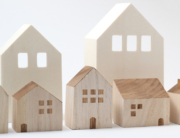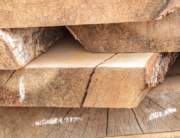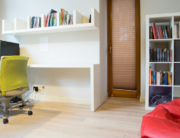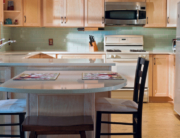Aesthetics are what everyone usually notices first…a beautiful backsplash, a stunning range hood, a gorgeous island countertop. But, for cooks working in the kitchen, it’s often what lies beneath the pretty exterior that ultimately makes them the happiest, and has the most lasting effects…an efficient tray divider, a deep drawer, a pull-out waste container.
In a trending world of minimal wall cabinets, open floor plans and an abundance of cooking gadgets and small appliances, it’s these hidden storage gems that often take center stage, enhancing a kitchen’s function while adding to its beauty.
This month KBDN asked several designers to discuss kitchen storage and how they help their clients store all of the usual, as well as unusual, items that find their way into the cooking space.
Kricken Yaker, designer/owner
Vanillawood
Lake Oswego, OR
Storage trends/philosophies: “We try really hard to create storage that is hidden, but keeps contents easily accessible. It’s one thing to design a beautiful kitchen, but it’s also important to think about it from an everyday standpoint.
“We like to use appliance garages and panels for appliances so they are streamlined and hidden behind whatever element the kitchen is made of. We also do a lot of open shelving and custom ventilation where we try to hide it with cabinetry or drywall. In general, we focus on coming up with thoughtful ways of tucking away and disguising the functional aspects of the kitchen.”
Most difficult storage challenges: “Everyone wants it all, but the reality is that most everyone has a budget, so not everything on the wish list always makes it into the final plan. One thing everyone seems to want right now is a wine refrigerator in the kitchen. Since we tend to do a lot of contemporary designs without walls that designate the kitchen area, it gives us freedom to let the kitchen spill over into a family room or dining area.
“And, because we design and build locally, our cabinetry is more affordable and we can be extremely thoughtful about personalizing storage for spices, recycling, composting, etc. based on a client’s usage of the space. But there is still a lot of millwork involved when you consider accessories, so there can be more cost up front, but it can also get expensive if you buy aftermarket accessories, too.”
Favorite storage element: “I love appliance garages on the counter for coffee makers, toasters, juicers, etc. We include outlets so everything stays plugged in, but you can close the door and hide all of the contents. Right now we’re doing a lot with French-style doors. You can open it up and there is a counter where you can have a breakfast station. We’ll also include storage above and below it.”
Favorite storage tip: “Use all drawers. Drawers are great because you can access every corner. In cabinets with doors, you have to bend down to see what’s inside.
“Make sure to include a garbage pull-out, with recycling and maybe a composting bin. It’s nice to have it right next to the sink rather than underneath where there is a lot of plumbing and a garbage disposal that takes up a lot of room.”
Diane White, owner
Studio3
Boulder, CO
Storage trends/philosophies: “Storage is no longer what it used to be. It used to be that people wanted to store everything in or near their kitchen. Now we are going into a minimalist movement where people are decluttering and moving things off the countertop. Shows like HGTV have really made an impact on how people think about storage and what to do with all their stuff. Looking at my demographics, a lot of my clients are baby boomers. They no longer want to store four sets of dishes and 50 vases. Nor do they want to store everything they’ve had in their basement…they want to get rid of it.
“Now my clients are looking at storing only what they use every day in their kitchen. Items they use only once a week or once a month can go in a pantry.”
Most difficult storage challenges: “Many kitchens just aren’t big enough. To help find more storage, I get creative and create cabinets that are multi-functional. I also sometimes make toe kicks that are 6″ high so I can include a drawer for cookie sheets and broiler pans. I have also done cabinets near entryways for briefcases, phones, etc., which become a drop-off counter as people come into the house.”
Favorite storage element: “I love large pots/pans drawers that are 36″to 48″ wide…and so do my clients. I’ll put 48″ stainless steel drawers under a 48″ range top. It looks gorgeous! My clients can fit all of their pots and pans with lids inside, and with today’s drawer glides, they are easy to open and smooth to operate.”
Favorite storage tip: “I encourage my clients to consider what they really need to store in the kitchen and what is secondary and can be stored near the kitchen.”
Jennifer Thompson, Owner/CKD
Creative Cabinets and Design
Birmingham, AL
Storage trends/philosophies: “The two words I hear most often are ‘clean’ and ‘simple.’ Most of my clients don’t want to see anything on the counter, so we are not only having to find places to store all of the kitchen wares, but we are also having to find places to hide everything. That means kitchens are getting bigger. People aren’t using less, they just want to hide it all so there has to be a place to put everything. In many of our remodels, we are taking in other rooms to make space for a huge kitchen.
“Electronics are also moving into the cooking space. Families revolve around the kitchen, and a lot of my clients are adding TVs. Sometimes I’ll put one above the refrigerator behind pocket doors. Other times I will put one underneath a wall cabinet or in a sitting area next to the kitchen, along with a couple of chairs or a loveseat. I will also almost always have a charging station hidden in an appliance garage, drawer or pantry.”
Most difficult storage challenges: “The most difficult challenges are for unusual requests, such as how to create a pet area in the kitchen. I have seen a lot of interest in this on Houzz and Pinterest. As designers, we have to figure out how to make those unusual requests work, keeping in mind that any remodel has to be an improvement on the space and storage.
“Maximizing storage in small spaces can also be challenging, but with so many accessories available, we can make it work.”
Favorite storage element: “Mine is pretty basic. Two main requirements I include in all of my kitchen designs are wastebasket pull-outs and pots/pans storage. People just don’t like to see garbage cans sitting out. They want to walk into their space and see a clean kitchen…the less clutter, the better. If I do two prep stations, I will often include two wastebasket pull-outs. And, for people who recycle, I will do a double pull-out: one for waste and one for recyclables. I also love the really, really big, deep pots and pans drawers…at least 24″ or 27″ wide and 36″ wide if I have enough space. I put one to each side of the range or cooktop.”
Favorite storage tip: “Before anything is finalized, know where everything will go. My clients are thinking through their kitchen designs much more thoroughly these days. Designs are taking longer to finalize, with some people taking as long as a year to plan their kitchen. But I think they are more purposeful.
“People know they have a lot of stuff, and they want their kitchen to be an improvement over the existing space, so designs are very methodical. Every cabinet has to make sense. For each and every one, we figure out what it will be used for. Everything has to have a place, but it also has to be pretty.
“Design just isn’t as simple as it used to be, where we ordered stock cabinets and figured out later what to do with them. Now, people are spending more time shopping, going online and pinning ideas from Houzz and Pinterest.”
Gianna Santoro, designer
Deane, Inc.
New Canaan, CT
Storage trends/philosophies: “Design
trends such as floating shelves are changing storage needs, especially when it comes to dishes, which I then move to a base cabinet with peg drawers. Floating shelves do still provide storage…but they are much more graphic storage with an open look so they do have an effect on storage, and it needs to be made up somewhere else.
“I also don’t see seated desks in kitchens anymore. People don’t have big computers in the kitchen, so they don’t need a standard 30″ desk. Instead, they’ll bring their tablet to the island and they’ll have their calendars on their phones. What I often include instead of a desk is a message center that is part of the cabinetry and is at the same height as the counter. People can also use a couple of shelves as a place to drop mail, and I’ll add outlets inside a drawer for charging electronics. Sometimes I also add corkboard behind a door so my clients can easily access things like invitations, etc. It’s less formal than a desk, but still provides a home for everything.”
Most difficult storage challenges: “I recently redesigned a kitchen where the homeowner had been storing all of the kids’ arts and crafts supplies, dining room items and holiday linens in the kitchen. Items such as these, that aren’t being used daily, should be out of the main kitchen and moved elsewhere, such as to a hallway closet. That frees up the kitchen for items that are used on a daily basis.”
“To create more storage, I have also included banquettes in my designs. They work great for kids’ games. I actually include them in many designs, although not all of them have storage. Depending on the angle, if they have an exposed end, I can add drawers and give easy access to items inside.”
Favorite storage element: “In our showroom we have a tall, narrow pull-out pantry that is open on both sides and has integrated lighting. Underneath we included a pull-out for spices. We also have a pull-out under a sink base that gives easy access to cleaning supplies. There is even a dish towel rod. Everything is right there…and it is so much better than those tilt-outs at the sink!”
Favorite storage tip: “If the ceiling is high, people often want to take the cabinets up high, too. But whatever is stored up high is out of sight…and out of mind. I like to do a single cabinet door that has two panels, giving the impression of two separate doors. That way you can open the door, stand back and still see what’s on the top shelf. Otherwise, the only way to see what is up there is to somehow get up there and open the second door. You can still use that upper space for items you don’t use on a daily basis, but you will see them more often, and most likely use them more often, too.”
Valery Tessier, senior design professional
BOWA
McLean, VA
Storage trends/philosophies: “People want to have less cluttered countertops, so they want to tuck away items like stand mixers, toasters, etc. That requires designers to come up with creative solutions that hide them but still keep them accessible.
“Roll-out shelves make such a difference for storing items in base cabinets, as well as in pantries. Another alternative is an appliance garage, which has evolved from the 1980s connotation. Now doors can be aluminum, and they can swing out, pocket in, or tip or lift up. There are so many more hardware options available that we can be creative and our clients can leave appliances on the counter behind doors so they aren’t a cluster of small appliances that makes the space feel cluttered.
“The DC area is also very traditional and very transient. People come and go and, when they remodel, they have to consider reselling their home so they don’t tend to go way out. Because of that, and because of the formal nature of the homes in this area, we don’t see many open shelves. But I do see people putting glass doors on upper cabinets, whether or not they want to display anything.”
Most difficult storage challenges: “The kitchen has become the drop zone. It’s where kids do homework and where people pay bills. That can create problems related to paper, so I am putting in more document storage, whether it’s file drawers, a series of small drawers or cubbies. So much can be done on the go these days…mail can be sorted and bills paid while cooking, so the kitchen desk has evolved into a miniature home office.
“The kitchen is also a ‘family’ room, so I might include a television or speakers for Sirius or Pandora, although putting electronics in the kitchen is really a mixed bag for my clients. But, for those who do have them in the kitchen, there are architecturally decorative electrical accessories to accommodate them.”
Favorite storage element: “Concealed trash cans and recycling bins in a cabinet may be considered accessories, but they are must-haves for me. I’ve also been doing more cutlery dividers in drawers and, at the sink, I always try to have a tilt-out with bins. Roll-out shelves are also key where anything is deeper than two rows. I also like tray dividers that allow you to store cookie sheets and cutting boards. All of these are part of a basic kitchen for our designs.
“About a year ago, one of my designs had a very deep drawer in a base cabinet. To keep items accessible, we split the drawer into two shallow drawers accessible behind one drawer front. Shallow drawers are great for storing things like serving platters, muffin tins and cooling racks. When drawers get too deep, you end up stacking everything and it is difficult to get to what is at the bottom. That is really the beauty of accessories…they keep things within reach. It is our goal to make the cooking experience more fun and easy.”
Favorite storage tip: “Take the time to plan properly. It might mean long meetings and taking inventory. But then you can account for everything and make sure storage is adequate. Although aesthetics are often what drive people into doing a remodel, storage plays such an important role in how the kitchen functions, more so than what the cabinet doors look like. And, these days, we can enhance the aesthetics with proper storage.
“Spending time in the planning stage also forces you to look at the details. It’s not always fun, and it can be tedious, but it’s so rewarding at the end when the client says the kitchen is the best area of the house. That’s why I do what I do. However hard or long those meetings are, they are all worth it when clients are happy.”
This article originally appeared at kitchenbathdesign.com.






